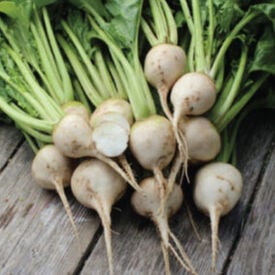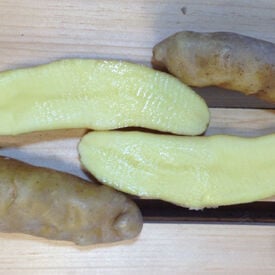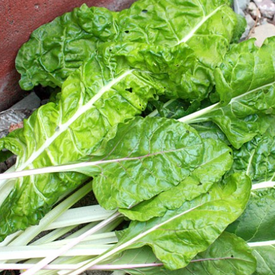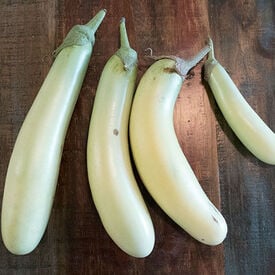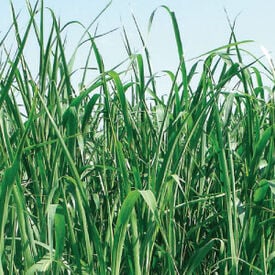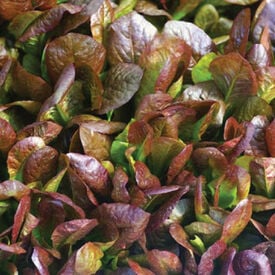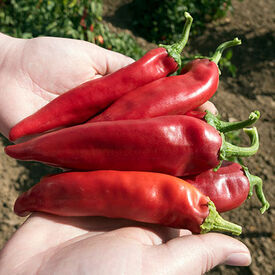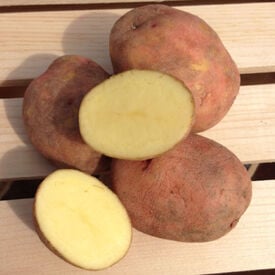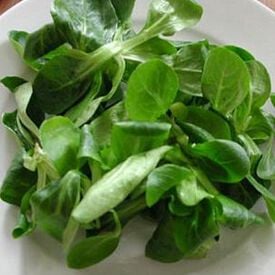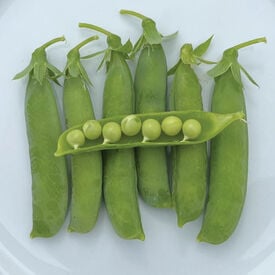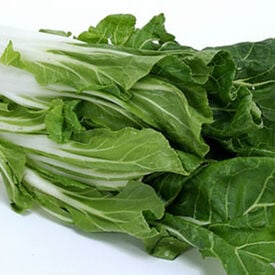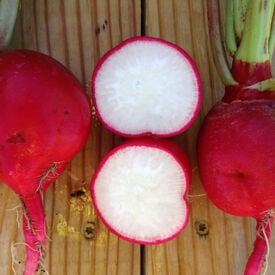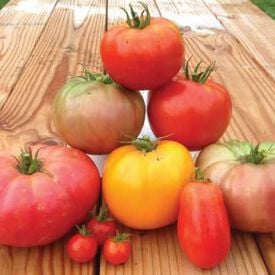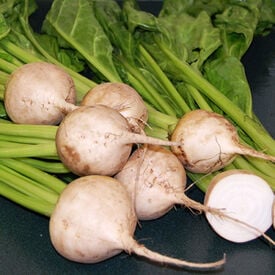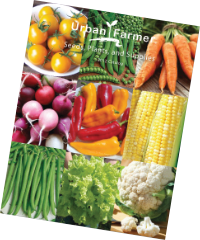The White Albino beet plants produce good yields of very sweet white beets. The beets are white and will never stain again! This gourmet beet is ideal for boiling, pickling, baking, and freezing.
SPRING SHIPPING - Certified - The Banana Fingerling is a beautiful light brown skinned potato with a creamy inside! This variety is the most popular fingerling and it's also the easiest to grow. Developed in Europe, the Banana Fingerling is proclaimed to be excellent in salads. It is used amongst chefs and gourmet markets. The yellow, banana-shaped, waxy tubers have a firm texture that has wonderful flavor when baked, boil or steamed Mid-season!
The Tasty Evergreen Tomato is a green fleshed heirloom with a tasty, strong sweet flavor. This tomato was introduced by Glecklers Seedmen of Metamora, Ohio in 1956. This delicious large heirloom ripens to grapefruit yellow with a lime-green flesh, giving it a very sweet flavor. This very productive, medium-sized beefsteak grows well throughout the United States. The Tasty Evergreen produces a continual harvest throughout the season.
The Lucullus Swiss Chard produces highly nutritious leaves from early spring until the first hard freeze in the fall. This variety produces great during the summer heat. This chard is a very popular variety grown throughout the United States.
Spring Raab broccoli, also known as rapini, has roots in Mediterranean cuisine, particularly in Italy, where it has been cultivated for centuries. This unique vegetable is characterized by its slender, green stalks topped with small yellow flowers and dark green leaves, which are edible and packed with nutrients. The flavor of Spring Raab is distinctively bitter and nutty, which softens with cooking, making it a versatile addition to dishes like stir-fries and pasta. Harvesting typically occurs 40-60 days after planting, ideally before the flowers fully open for optimal taste. This cool-season crop thrives in well-drained soil and prefers cooler temperatures, making it perfect for early spring or fall planting. Its rapid growth and ability to produce multiple harvests make Spring Raab a favorite among gardeners, while its rich vitamin content adds to its appeal for health-conscious cooks.
The prolific Louisiana Long Green Eggplant is an attractive banana-shaped variety that has a delicious full-bodied nutty flavor. This Southern heirloom variety is best picked young, with its white slightly green-ish skin, for optimal texture and flavor. This tall eggplant plant produces 8-9 inch long fruits that are slender and easy to cook with.
The Piper Sudangrass is a great catch crop for excess nitrogen that produces heavy amounts of organic matter and suppresses weeds. This grass grows quickly at heights up to 7 feet. The Piper Sudangrass is great for livestock forage, but should be grazed only when mature and never after a frost as it turns toxic. Uses: Erosion Control, Green Manure, Nitrogen Scavenger, No Till, Organic Matter (Biomass), Weed Suppression
The Cimarron is a very beautifully colored romaine lettuce! This tasty lettuce has bright green-red leaves that fade to deep red tips. This romaine type lettuce has good disease and bolt resistance. Cimarron is a favorite among gardeners for its beautiful hue and crispy texture in salad mixes!
The Copia Tomato is a yellow and red striped beefsteak variety that is a cross between the Green Zebra and Marvel Striped. This sweet and juicy tomato is perfect for slicing and adding to salads and sandwiches for a sweet and tangy kick! This beefsteak can weigh 10-12 ounces each.
The mildly spicy Joe Parker Pepper is a Southwestern style traditional Anaheim that can be harvested green or red! This deliciously crisp pepper quickly changes from green to red and can be eaten at both color stages. The Joe Parker is perfect for stuffing, grilling, roasting or processing. This organic pepper plant produces high yielding semi flattened uniform fruits. Certified Organic. Learn more about our organic seeds.
SPRING SHIPPING - Certified - The crisp, yellow flesh of the Red Gold Potato is great for making fries! This potato variety produces medium sized tubers with light red skin wrapped around a delicate yellow flesh that has the texture and flavor that no other potato has! Red Gold is a semi-moist, high yielder and shows some resistance to scab. Red Gold potatoes are excellent steamed, boiled, baked, fried, mashed, roasted or scalloped! This delicious red skinned potato was named after the Red River, which runs between North Dakota and Minnesota.
Vit Mâche, also known as corn salad, lamb’s lettuce, or mâche, is a cool-season leafy green with a long history in Europe, where it was foraged in fields and vineyards before becoming a cultivated crop in the 17th century. This compact plant forms small rosettes of tender, spoon-shaped leaves that are deep green and naturally high in vitamins A and C. Its flavor is mild, slightly nutty, and gently sweet, making it a favorite for winter and early-spring salads. Mâche thrives in cool weather, germinating best in fall or early spring, and prefers rich, well-drained soil with consistent moisture. It’s cold-tolerant enough to survive light frosts, allowing gardeners to harvest the delicate rosettes over a long season with minimal care.
The Lunar White is a rare white carrot with high yields! This is a very productive carrot with creamy white roots. The Lunar White has a mild, but delicious flavor with small core.
Thomas Laxton is an heirloom pea plant that is big and productive. At Urban Farmer we have trialed these a few times and they are always are favorite shelling pea. The peas are always sugary and delicious. This pea variety is named after the famous pea breeder, Thomas Laxton. This old heirloom pea is over a century old and has withstood the test of time. Each pod contains at least 8 peas and often up to 10! Make sure to support the Thomas Laxton's 3' vines with a trellis.
Fordhook Giant is a popular standard for many home gardens. This variety is one of best tasting Swiss Chards! The Fordhook Giant grows to be a dark glossy green color with a deeply savory leaf.
Crimson radish is a vibrant and flavorful variety of radish that stands out for its striking color and crisp texture. Originating from traditional radish cultivars, Crimson radish has been cultivated for its eye-catching appearance and peppery taste. This variety is known for its round, smooth roots, which boast a deep red to crimson skin and a white, crunchy interior. The flavor is typically sharp and tangy, with a satisfying bite that enhances salads, sandwiches, and garnishes. Crimson radishes generally mature in about 25 to 30 days, making them a quick and rewarding crop for gardeners. The plants exhibit a compact, upright growth habit, growing to a height of about 6 to 12 inches with a spread of 6 to 8 inches. They thrive in cool weather and well-drained soil, preferring full sun to partial shade. Their rapid growth and ease of cultivation make them ideal for successive plantings, providing a steady supply of fresh radishes throughout the growing season. With their vibrant color, crisp texture, and zesty flavor, Crimson radishes are a popular choice for adding both visual appeal and flavor to the garden and kitchen.
The Heirloom Blend is a collection of 8 distinctively different heirloom tomato varieties! If you like the fresh taste of heirloom tomatoes, then try this beautiful rainbow blend of tomatoes. We have hand selected our 8 favorite heirlooms and blended them together to create a wonderful assortment of mouth-watering, colorful, and multiple use tomatoes. The Heirloom Blend includes Marglobe Supreme, Black Krim, Rutger, Pink Brandywine, Cherokee Purple, Golden Jubilee, Sweetie Cherry and Roma.
The Avalanche beet, scientifically known as Beta vulgaris var. conditiva 'Avalanche,' is a popular variety of beetroot that has gained recognition for its exceptional characteristics. Historically, beets have been cultivated for thousands of years, with evidence of their consumption dating back to ancient civilizations like the Egyptians and Greeks. The Avalanche beet is a modern cultivar that has been selectively bred for its unique attributes. Avalanche beets are renowned for their mild, sweet flavor and tender texture. They are typically harvested at a smaller size, around 2-3 inches in diameter, making them ideal for salads, roasting, and pickling. The days to maturity for Avalanche beets range from 45 to 50 days, making them a relatively quick-growing crop. These beets are characterized by their crisp, pure white flesh and skin, giving them their distinctive appearance. They are also known for their resistance to common beet diseases such as Cercospora leaf spot and Rhizoctonia root rot, which can help ensure a healthy yield. When growing Avalanche beets, it's essential to provide them with well-draining, loose soil that is rich in organic matter. They thrive in full sun but can tolerate partial shade. Proper spacing is crucial, with rows spaced about 12-18 inches apart and individual beets planted 2-4 inches apart within the rows. Adequate watering is necessary to keep the soil consistently moist, but not waterlogged. With the right care and growing conditions, Avalanche beets can yield an abundant harvest of these delightful, mild-flavored, and visually striking vegetables.
